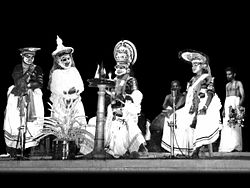- Kutiyattam
-
El teatro sánscrito kutiyattam Patrimonio Cultural Inmaterial

Nombre descrito en la Lista del Patrimonio Inmaterial.
El gurú Māṇi Mādhava Chākyār y su grupo interpretando Thoranayudham (parte de la escena Abhiṣeka Nataka de la obra Bhāsa, basada en la épica Ramayana) en Chennai en 1962. Esta fue la primera presentación de Kutiyattam fuera de Kerala.País  India
IndiaTipo Cultural inmaterial N.° identificación 00010 Región Asia y Pacífico Año de inscripción 2001 (como Obra Maestra del Patrimonio Oral e Intangible de la Humanidad, y como PCI en el 2008, III Sesión) [[Archivo:|thumb|300px|.]] El Kutiyattam (en malayalam: കൂടിയാട്ടം, AITS: Kūṭiyāṭṭaṃ) o Koodiyattam es una forma de teatro sánscrito tradicional del estado de Kerala, en India. Es interpretada en lenguaje sánscrito en templos hindú desde hace más de 2000 años. Es reconocida oficialmente por la UNESCO como una de las Obras Maestras del Patrimonio Oral e Intangible de la Humanidad.
Māṇi Mādhava Chākyār (1899 - 1990) es considerado como el máximo exponente de esta danza en los tiempos modernos.
Las funciones siempre van acompañadas de música en vivo, la que tiene como actor principal al chenda. A diferencia del kathakali, donde los papeles de mujeres son tradicionalmente interpretados por hombres, en el kutiyattam sí actúan mujeres.
-
Intérpretes de chenda, instrumento de percusión usado en la música en vivo.
-
Māṇi Mādhava Chākyār interpretando una obra de Kutiyattam.
-
A diferencia del kathakali, en el kutiyattam sí pueden actuar mujeres.
Bibliografía
- Chakiar, Mani Madhava (1975), Nātyakalpadrumam, Sangeet Natak Akademi, Nueva Delhi
- Raja, Kunjunni (1964), An Introduction to Kutiyattam, Sangeet Natak Akademi, Nueva Delhi
- Kavalam N. Panikar (1994), Mani Madhava Chakyar: The Master at Work, Sangeet Natak Akademi, Nueva Delhi
Categorías:- Kerala
- Danza en la India
- Patrimonio Cultural Inmaterial de la Humanidad en India
-
Wikimedia foundation. 2010.



